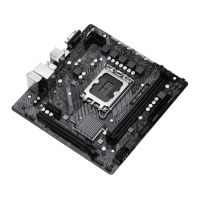
Do you have a question about the ASROCK H610M-HVS and is the answer not in the manual?
| Processor socket | LGA 1700 |
|---|---|
| Processor manufacturer | Intel |
| Compatible processor series | Intel Celeron, Intel Core i3, Intel Core i5, Intel Core i7, Intel Core i9, Intel Pentium |
| Maximum number of SMP processors | 1 |
| Audio chip | Realtek ALC887 / Realtek ALC897 |
| Component for | PC |
| Motherboard chipset | Intel H610 |
| PC health monitoring | CPU, FAN, Temperature, Voltage |
| Audio output channels | 7.1 channels |
| Motherboard form factor | micro ATX |
| Windows operating systems supported | Windows 10 x64, Windows 11 x64 |
| Non-ECC | Yes |
| Number of memory slots | 2 |
| Supported memory types | DDR4-SDRAM |
| Maximum internal memory | 64 GB |
| Supported memory clock speeds | 3200 MHz |
| Cables included | SATA |
| DVI-D ports quantity | 0 |
| USB 2.0 ports quantity | 4 |
| Wi-Fi | No |
| LAN controller | Realtek RTL8111H |
| Ethernet interface type | Gigabit Ethernet |
| Maximum resolution | 4096 x 2160 pixels |
| Parallel processing technology support | Not supported |
| BIOS type | UEFI AMI |
| ACPI version | 6.0 |
| BIOS memory size | 128 Mbit |
| System Management BIOS (SMBIOS) version | 2.7 |
| Supported storage drive types | HDD & SSD |
| Supported storage drive interfaces | SATA III |
| Harmonized System (HS) code | 84733020 |
| Depth | 188 mm |
|---|---|
| Width | 197 mm |
Lists included items: motherboard, guides, cables, and I/O shield for system setup.
Details technical specifications: platform, CPU, chipset, memory, slots, graphics, audio, LAN, I/O, storage, connectors, BIOS, OS, certifications.
Visual diagram of the motherboard labeling key connectors, slots, and components with corresponding numbers for identification.
Illustrates and lists rear I/O panel ports and connectors for H610M-HDV and H610M-HVS models for peripheral connectivity.
Guides on safely installing the CPU into the motherboard socket, including essential handling precautions for preventing damage.
Provides instructions and diagrams for mounting the CPU cooler and fan onto the motherboard post-CPU installation for thermal management.
Explains DDR4 memory installation into DIMM slots, emphasizing dual-channel configuration and compatibility for optimal performance.
Describes available PCIe slots, their types (x1, x16), and intended uses for adding expansion cards like GPUs and peripherals.
Details the function and usage of motherboard jumpers, specifically the Clear CMOS Jumper (CLRMOS1) for system reset and default configuration.
Explains pin assignments and functions for onboard headers such as System Panel, Chassis Intrusion, and Front Panel Audio for case component connections.
Guides on using the support CD to install necessary drivers and utilities for enhancing motherboard functionality and performance.
Introduces ASRock's A-Tuning utility for system monitoring, fan control, and performance tuning, detailing installation and features.
Explains using the ASRock Live Update & APP Shop for downloading software, drivers, and BIOS updates to keep the system optimized and current.
Explains how to access and navigate the UEFI SETUP UTILITY for system configuration, covering startup methods and basic operation.
Describes the EZ Mode interface of the UEFI BIOS, functioning as a dashboard for essential system status and basic controls.
Introduces the Advanced Mode of the UEFI BIOS, offering comprehensive options for detailed system configuration and fine-tuning.
Details the Main screen of the UEFI SETUP UTILITY, presenting system overview and allowing customization of favorite BIOS settings.
Explains the OC Tweaker screen for system overclocking, detailing CPU, DRAM, and voltage configurations for performance enhancement.
Covers advanced system configurations like CPU, Chipset, Storage, ACPI, USB, and Trusted Computing settings for detailed control and tuning.
Outlines utility tools within UEFI BIOS, including UEFI Tech Service, SSD Secure Erase, Instant Flash, and Network Configuration for system management.
Details the hardware monitoring screen for tracking system status, covering CPU/motherboard temperatures, fan speeds, and voltages.
Explains setting supervisor/user passwords, configuring Secure Boot, and managing Intel(R) Platform Trust Technology for system security.
Covers boot options, priorities, fast boot, and CSM configuration, enabling users to manage the system's startup sequence and devices.
Describes options for saving/discarding changes, loading defaults, and exiting the UEFI SETUP UTILITY after configuration.
